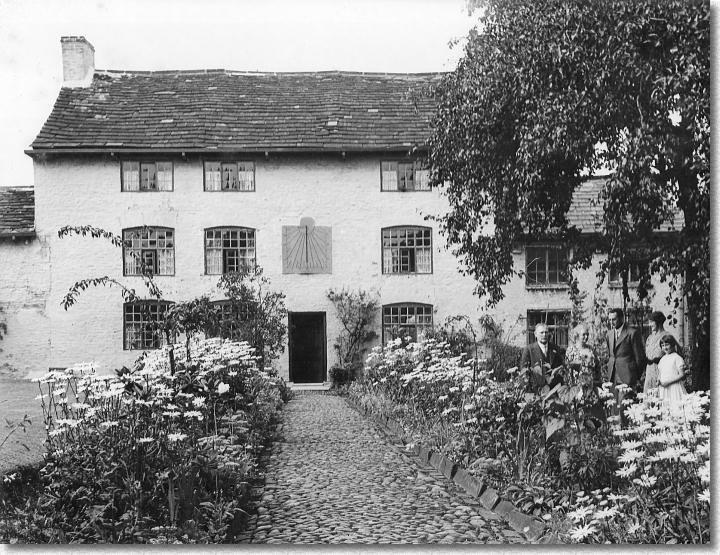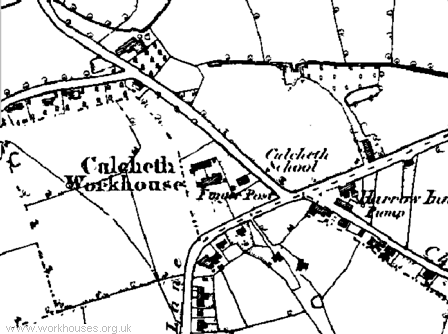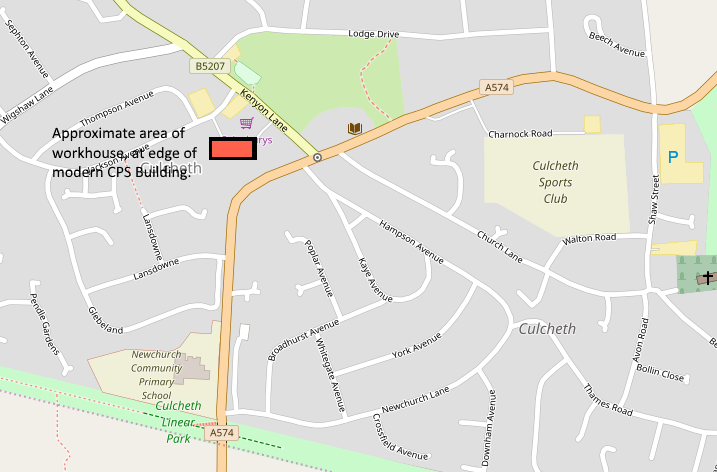2017-03-09 Culcheth Workhouse and Pauper Apprentices
20170309 Culcheth Workhouse and the pauper apprentices.
This was a well researched and detailed talk given by our Chair Zoe Chaddock, which described the origins of Culcheth workhouse as well as aspects of the inmates' lives, using a variety of maps, original documents and a 3D (three dimensions) animation of the workhouse building. The latter gave an insight into the probable layout and use of the building and the site in general. These showed the extension and development of the original building and its later weaving shed, part of the profits of which went to the workhouse governor, an incentive for him to keep inmates working.
Photo of Culcheth Workhouse:

This shows the part leading straight to what is now the bend in the warrington road. The House was about eighty yards back from the road.
We learnt how and when the workhouse was established, heard about the rules which governed the everyday lives of the inmates, their diet and how their time was employed.
Albeit some must not have been properly fed as a parliamentary report now at Kew, shows a certain inmate died ‘allegedly from want’ in 1840. Refer “Jessie Redfern, weaver, Culcheth Workhouse, in reference document at the bottom of page.
Pauper Apprentices
The second part of the talk focussed on the pauper apprentices, some of whom had been inmates. We were told the ages at which the children were apprenticed, into what trade and where they were sent and learnt of the conditions under which some of the children would have laboured.
As the ability to get help from a parish depended on “right of settlement” or “declared settlement” in the parish, which was obtained at birth or by seven (7) years apprenticeship in the parish, this illuminated the reason for long 7 year apprenticeships. As after such an apprenticeship the apprentice had ‘settlement’ in that parish, and in case of poverty could seek relief in that parish.
This ‘declared settlement parish’ avoided folk moving from poor parishes to richer parishes (to be a burden on their taxation sources) to seek help and was regulated by the 1662 Settlement Laws which were passed to avoid mobility from poor to richer areas. Unfortunately, the laws greatly discouraged the unemployed from leaving the parish of their birth in order to find work elsewhere.
[Analogous to the present Russian system of internal passports, Паспорт гражданина Российской Федерации**, which define in which areas persons can live and work. **These are currently being replaced with “Identity Cards” with the same restrictions.]
We were also treated to stories of three individuals who had lived in the workhouse or been child apprentices.
Other Photos of the workhouse are in our display presentation article report. Links below:
http://www.clhg.org.uk/index.php/reports-future-events/culcheth-workhouse-display
http://www.clhg.org.uk/index.php/reports-future-events/rules-of-culcheth-workhouse
Location of workhouse on old and present maps.

Ex informative website www.workhouses.org.uk (see link below)
Current Open Street Map of area with insert location marked.)
General Information.
General information on the workhouse sytem are located on internet in articles linked below:
BBC Podcast
http://www.historyextra.com/workhouse
Website links
A well recommended read is the site by Peter Higgenbotham
A detailed site about the workhouse system, its history, laws and use in varous countries.

